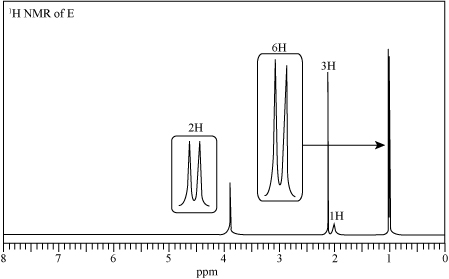
Concept explainers
Identify the structures of D and E, isomers of molecular formula
a. IR absorption for D at

b. IR absorption for E at

Want to see the full answer?
Check out a sample textbook solution
Chapter 22 Solutions
ORGANIC CHEMISTRY >ACCESS CODE<
- 22. A compound with the molecular formula C8H8O produces an IR spectrum with signals at 3063, 1686, and 1646 cm-1. The 1H NMR spectrum of this compound exhibits a singlet at 2.6ppm(l=3H), and a multiplet at 7.5(l= 5H). Draw the structure and give the common name of this compound . Show the correlations between the structure and spectra.arrow_forwardWhat is the structure of the compound with the formula C6H12O2, if it has a strong IR signal near 2900 and 1740 cm-1, the 1H-NMR spectrum is: 1.12 ppm (3H triplet) 1.25 ppm (6H doublet) 2.27 ppm (2H quartet) 5.02 ppm (1H septet)arrow_forwardCompounds B and C are isomers with molecular formula C5H9BrO2. The 1H NMR spectrum of compounds B and C are shown below. The IR spectrum corresponding to compound B showed strong absorption bands at 1739, 1225, and 1158 cm-1, while the spectrum corresponding to compound C have strong bands at 1735, 1237, and 1182 cm-1. 1.Based on the information provided, determine the structure of compounds B and C. 2.Assign all peaks in 1H NMR spectrum of compounds B and C.arrow_forward
- What is the structure of the compound with the formula C5H12O, if it has a strong broad IR signal centered near 3330 cm-2, and the 1H-NMR spectrum is: 0.91 ppm (3H triplet) 1.19 ppm (6H singlet) 1.50 ppm (2H quartet) 2.24 ppm (1H singlet)arrow_forwardThe 1H and 13C NMR spectra of compound A, C8H9Br are shown below. Answer the following questions. 1(a) Degree of the unsaturation of this compound is = , 1(b) The derived unsaturation number indicates that compound has ............= 1(c) Two peaks in between 6.5 - 8.0 δ indicate that compound is= 1(d) According to the splitting pattern of the peak at 1.20 δ and 2.58 δ indicates that compound has a .................. group= 1(e) According to the 1H NMR spectrum the number of nonequivalent aromatic proton sets in the compound = 1(f) According to the 13C NMR, the number of nonequivalent carbons in the compound is = 1(g) According to your answer in Q 1(f) the compound has a plane of symmetry Yes or NO = 1(h) The IUAC name for this unknown compound isNOT TOO SURE ABOUT MY ANSWERS, PLEASE CORRECT ME IF I'M WRONGarrow_forwardWhat are the functional groups or peaks for this C6H14O IR spectra?arrow_forward
- What are the major IR bands, 1H-nmr signals, And the m/z of the following compounds benzaldehydearrow_forwardA. explain each step with words on how to get the structure. Step 1: Calculate the Index of Hydrogen Deficiency (IHD). Step 2: Use IR to determine obvious functional groups. Step 3: Use 1H-NMR to determine structural details. Step 4: Confirm the final structure using 13C-NMR.arrow_forwardDraw the structure of a compound, C4H8O3 that exhibits IR absorptions at 1710 and 2500-3000 cm-1 and thefollowing 1H NMR signals: 11.1 (1H, singlet), 4.14 (2H, singlet), 3.63 (2H, quartet), 1.26 (3H, triplet) ppm.arrow_forward
- The H1H1 NMR spectrum shown corresponds to an unknown compound with the molecular formula C6H10C6H10. There are no strong IR bands between 2100 and 2300 or 3250 and 3350 cm−1. Deduce and draw the structure of the molecule that corresponds to the spectrum.arrow_forwardAssume a compound with the formula C4H8O. a) How many double bonds and/or rings does your compound contain? b) If your compound shows an infrared absorption peak at 1715 cm-1, what functional group does it have? c) If your compound shows a single 1H NMR absorption peak at 2.1 δ, what is its structure?arrow_forwardFigures 2 to 4 show the IR, 1H NMR and 13C NMR spectra of a compound with formula C3H5N 2a) Identify bands A and B in the IR spectrumarrow_forward

 Organic ChemistryChemistryISBN:9781305580350Author:William H. Brown, Brent L. Iverson, Eric Anslyn, Christopher S. FootePublisher:Cengage Learning
Organic ChemistryChemistryISBN:9781305580350Author:William H. Brown, Brent L. Iverson, Eric Anslyn, Christopher S. FootePublisher:Cengage Learning EBK A SMALL SCALE APPROACH TO ORGANIC LChemistryISBN:9781305446021Author:LampmanPublisher:CENGAGE LEARNING - CONSIGNMENT
EBK A SMALL SCALE APPROACH TO ORGANIC LChemistryISBN:9781305446021Author:LampmanPublisher:CENGAGE LEARNING - CONSIGNMENT Macroscale and Microscale Organic ExperimentsChemistryISBN:9781305577190Author:Kenneth L. Williamson, Katherine M. MastersPublisher:Brooks Cole
Macroscale and Microscale Organic ExperimentsChemistryISBN:9781305577190Author:Kenneth L. Williamson, Katherine M. MastersPublisher:Brooks Cole



